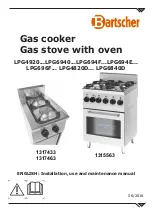
en
Tested for you in our cooking studio
30
Yoghurt
You can use your appliance to make your own yoghurt.
Remove accessories and shelf supports from the
cooking compartment. The cooking compartment must
be empty.
1.
Heat 1 litre of milk (3.5% fat) to 90 °C on the hob
and then leave it to cool down to 40 °C.
It is sufficient to heat UHT milk to 40 °C.
2.
Stir in 30 g (approx. 1 tbsp) (chilled) yoghurt.
3.
Pour into cups or small jars with lids and cover.
4.
Place the cups or jars onto the cooking
compartment floor and use the settings indicated in
the table.
5.
After making the yoghurt, leave it to cool in the
refrigerator.
Acrylamide in foodstuffs
Acrylamide is mainly produced in grain and potato
products prepared at high temperatures, such as potato
crisps, chips, sliced bread, bread rolls, bread or fine
baked goods (biscuits, gingerbread, spiced biscuit).
Preserving
For preserving, the jars and rubber seals must be clean
and intact. If possible, use jars of the same size. The
information in the table is for round, one-litre jars.
Caution!
Do not use jars that are larger or taller than this. The
lids could crack.
Only use fruit and vegetables in good condition. Wash
them thoroughly.
The times given in the tables are a guide only. The time
will depend on the room temperature, number of jars,
and the quantity and temperature of the contents.
Before you switch off the appliance or change the
cooking mode, check whether the contents of the jars
are bubbling as they should.
Preparation
1.
Fill the jars, but not to the top.
2.
Wipe the rims of the jars, as they must be clean.
3.
Place a damp rubber seal and a lid on each jar.
4.
Seal the jars with the clips.
Place no more than six jars in the cooking
compartment.
Settings
1.
Insert the universal pan at level 2. Arrange the
preserving jars so that they do not touch each other.
2.
Pour ½ litre of water (approx. 80 °C) into the
universal pan.
3.
Close the oven door.
4.
Set Bottom heat
$
.
5.
Set the temperature to 170 - 180 °C.
Preserving
Fruit
After approx. 40 to 50 minutes, small bubbles begin to
form at short intervals. Switch off the oven.
After 25 to 35 minutes of residual heat, remove the
preserving jars from the cooking compartment. If they
are allowed to cool for longer in the cooking
compartment, germs could multiply, promoting
acidification of the preserved fruit.
Dish
Accessories/cookware
Shelf position
Heating
function
Tempera-
ture in °C
Cooking time
Yoghurt
Cup/jar
Cooking compart-
ment floor
^
-
4-5h
Tips for keeping acrylamide to a minimum
General
■
Keep cooking times as short as possible.
■
Cook food until it is golden brown, but not too dark.
■
Large, thick pieces of food contain less acrylamide.
Baking
With top/bottom heating at max. 200 °C.
With hot air at max. 180 °C.
Biscuits
With top/bottom heating at max. 190 °C.
With hot air at max. 170 °C.
Egg or egg yolk reduces the production of acrylamide.
Oven chips
Spread out a single layer evenly on the baking tray. Cook approx. 400-600 g at once on a baking tray so
that the chips do not dry out and become crunchy.
Fruit in one-litre jars
When it starts to bubble
Residual heat
Apples, redcurrants, strawberries
Switch off
approx. 25 minutes
Cherries, apricots, peaches, gooseberries
Switch off
approx. 30 minutes
Apple purée, pears, plums
Switch off
approx. 35 minutes







































